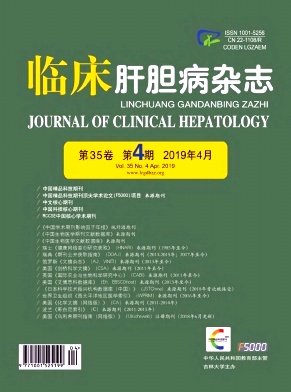|
[1]Pancreas Study Group, Chinese Society of Gastroenterology, Chinese Medical Association, Editorial Board of Chinese Journal of Pancreatology, Editorial Board of Chinese Journal of Digestion. Chinese guidelines for the management of acute pancreatitis (Shanghai, 2013) [J]. J Clin Hepatol, 2013, 29 (9) :656-660. (in Chinese) 中华医学会消化病学分会胰腺疾病学组, 《中华胰腺病杂志》编辑委员会, 《中华消化杂志》编辑委员会.中国急性胰腺炎诊治指南 (2013年, 上海) [J].临床肝胆病杂志, 2013, 29 (9) :656-660.
|
|
[2]NAWAZ H, MOUNZER R, YADAV D, et al. Revised atlanta and determinant-based classification:Application in a prospective cohort of acute pancreatitis patients[J]. Am J Gastroenterol, 2013, 108 (12) :1911-1917.
|
|
[3]XU HF, LI Y, YAN J, et al. Severity analyese of acute pancreatitis based on etiology[J]. Natl Med J China, 2014, 94 (41) :3220-3223. (in Chinese) 徐海峰, 李勇, 颜骏, 等.急性胰腺炎病因与其严重程度的关系[J].中华医学杂志, 2014, 94 (41) :3220-3223.
|
|
[4]HE WH, ZHU Y, ZHU Y, et al. Comparison of severity and clinical outcomes between hypertriglyceridemic pancreatitis and acute pancreatitis due to other causes[J]. Natl Med J China, 2016, 96 (32) :2569-2572. (in Chinese) 何文华, 祝荫, 朱勇, 等.高甘油三酯血症与其他病因所致急性胰腺炎的病情严重程度及预后比较[J].中华医学杂志, 2016, 96 (32) :2569-2572.
|
|
[5]ZHENG YM, ZHOU Z, LI HC, et al. A multicenter study on etiology of acute pancreatitis in Beijing during 5 years[J]. Pancreas, 2015, 44 (3) :409-414.
|
|
[6]FAN JJ, DING L, LU YY, et al. Epidemiology and etiology of acute pancreatitis in urban and suburban areas in Shanghai:A retrospective study[J]. Gastroenterol Res Pract, 2018, 2018:1420590.
|
|
[7]NESVADERANI M, ESLICK G, VAGG D, et al. Epidemiology, aetiology and outcomes of acute pancreatitis:A retrospective cohort study[J]. Int J Surg, 2015, 23 (Pt A) :68-74..
|
|
[8]WANG Q, WANG G, QIU ZY, et al. Elevated serum triglycerides in the prognostic assessment of acute pancreatitis:A systematic review and Meta-analysis of observational studies[J]. J Clin Gastroenterol, 2017, 51 (7) :586-593.
|
|
[9]BERGLUND L, BRUNZELL JD, GOLDBERG AC, et al. Evaluation and treatment of hypertriglyceridemia:An Endocrine society clinical practice guideline[J]. J Clin Endocrinol Metab, 2012, 97 (9) :2969-2989.
|
|
[10]China Adult Lipid Abnormality Prevention and Treatment Guidelines Revision Committee. Guidelines for the prevention and treatment of adult hyperlipidemia in China (2016 Revision) [J]. Chin Circulation J, 2016, 31 (10) :937-953. (in Chinese) 中国成人血脂异常防治指南修订委员会.中国成人血脂异常防治指南 (2016年修订版) [J].中国循环杂志, 2016, 31 (10) :937-953.
|
|
[11]BURSTOW M, YUNUS R, HOSSAIN M, et al. Meta-analysis of early endoscopic retrograde cholangiopancreatography (ERCP) ±endoscopic sphincterotomy (ES) versus conservative management for gallstone pancreatitis (GSP) [J]. Surg Laparosc Endosc Percutan Tech, 2015, 25 (3) :185-203.
|
|
[12]LLORET L, PELLETIER A, CZERNICHOW S, et al. Acute pancreatitis in a cohort of 129 patients referred for severe hypertriglyceridemia[J]. Pancreas, 2008, 37 (1) :13-20.
|
|
[13]GOYAL H, SMITH B, BAYER C, et al. Differences in severity and outcomes between hypertriglyceridemia and alcohol-induced pancreatitis[J]. N Am J Med Sci, 2016, 8 (2) :82-87.
|
|
[14]ZHENG YM, ZHOU X, GAO CC, et al. Risk factors analysis of early death for severe acute pancreatitis patients[J]. China Med Herald, 2017, 14 (13) :61-64. (in Chinese) 郑亚民, 周震, 高崇崇, 等.急性重症胰腺炎早期死亡的风险因素分析[J].中国医药导报, 2017, 14 (13) :61-64.
|
|
[15]CARIOCA A, JOZALA D, BEM L, et al. Severity assessment of acute pancreatitis:Applying Marshall scoring system[J].Rev Col Bras Cir, 2015, 42 (5) :325-327.
|
|
[16]BANKS P, BOLLEN T, DERVENIS C, et al. Classification of acute pancreatitis—2012:Revision of the Atlanta classification and definitions by international consensus[J]. Gut, 2013, 62 (1) :102-111.
|
|
[17]PETROV M, SHANBHAG S, CHAKRABORTY M, et al. Organ failure and infection of pancreatic necrosis as determinants of mortality in patients with acute pancreatitis[J]. Gastroenterology, 2010, 139 (3) :813-820.
|
|
[18]KIM D, CHUNG W, LEE J, et al. Analysis of factors associated with the severity of acute pancreatitis according to etiology[J]. Gastroenterol Res Pract, 2017, 2017:1219464.
|
|
[19]ZENG Y, ZHANG W, LU YY, et al. Impact of hypertriglyceridemia on the outcome of acute biliary pancreatitis[J]. Am J Med Sci, 2014, 348 (5) :399-402.
|
|
[20]WU CY, KE L, TONG ZH, et al. Hypertriglyceridemia is a risk factor for acute kidney injury in the early phase of acute pancreatitis[J]. Pancreas, 2014, 43 (8) :1312-1316.
|
|
[21]LI XY, KE L, DONG J, et al. Significantly different clinical features between hypertriglyceridemia and biliary acute pancreatitis:A retrospective study of 730 patients from a tertiary center[J]. BMC gastroenterology, 2018, 18 (1) :89.
|
|
[22]NAWAZ H, KOUTROUMPAKIS E, EASLER J, et al. Elevated serum triglycerides are independently associated with persistent organ failure in acute pancreatitis[J]. Am J Gastroenterol, 2015, 110 (10) :1497-1503.
|
|
[23]TSUANG W, NAVANEETHAN U, RUIZ L, et al. Hypertriglyceridemic pancreatitis:Presentation and management[J]. Am J Gastroenterol, 2009, 104 (4) :984-991.
|
|
[24]ALDIVIELSO P, RAMIREZ-BUENO A, EWALD N. Current knowledge of hypertriglyceridemic pancreatitis[J]. Eur J Intern Med, 2014, 25 (8) :689-694.
|
|
[25]CHRISTIAN J, ARONDEKAR B, BUYSMAN E, et al. Clinical and economic benefits observed when follow-up triglyceride levels are less than 500 mg/dl in patients with severe hypertriglyceridemia[J]. J Clin Lipidol, 2012, 6 (5) :450-461.
|
|
[26]CHAUDHARY A, IQBAL U, ANWAR H, et al. Acute Pancreatitis secondary to severe hypertriglyceridemia:Management of severe hypertriglyceridemia in emergency setting[J]. Gastroenterology Res, 2017, 10 (3) :190-192.
|
|
[27]YANG LL, LI C, WEI XH, et al. Study on the influence of continuous blood purification for serum disease related indexes of patients with severe acute pancreatitis[J]. J Clin Exp Med, 2017, 16 (2) :193-195. (in Chinese) 杨丽丽, 李川, 魏晓华, 等.连续性血液净化对重症急性胰腺炎患者血清疾病相关指标的影响研究[J].临床和实验医学杂志, 2017, 16 (2) :193-195.
|
|
[28]STEFANUTTI C, LABBADIA G, MOROZZI C. Severe hypertriglyceridemia-related acute pancreatitis[J]. Ther Apher Dial, 2013, 17 (2) :130-137.
|
|
[29]SZCZEPIORKOWSKI Z, WINTERS J, BANDARENKO N, et al.Guidelines on the use of therapeutic apheresis in clinical practice—evidence-based approach from the Apheresis Applications Committee of the American Society for Apheresis[J]. J Clin Apher, 2010, 25 (3) :83-177.
|
|
[30]HUANG SP, TOH DE, SUE Y, et al. Double filtration plasmapheresis in treatment of acute pancreatitis associated with severe hypertriglyceridemia:Three case reports[J]. Medicine, 2018, 97 (44) :e12987.
|
|
[31]KANDEMIR A, COSKUN A, YAVASOGLU I, et al. Therapeutic plasma exchange for hypertriglyceridemia induced acut pancreatitis:the 33 cases experience from a tertiary reference center in Turkey[J]. Turk J Gastroenterol, 2018, 29 (6) :676-683.
|







 DownLoad:
DownLoad: